1993 BUICK PARK AVENUE power steering
[x] Cancel search: power steeringPage 67 of 340
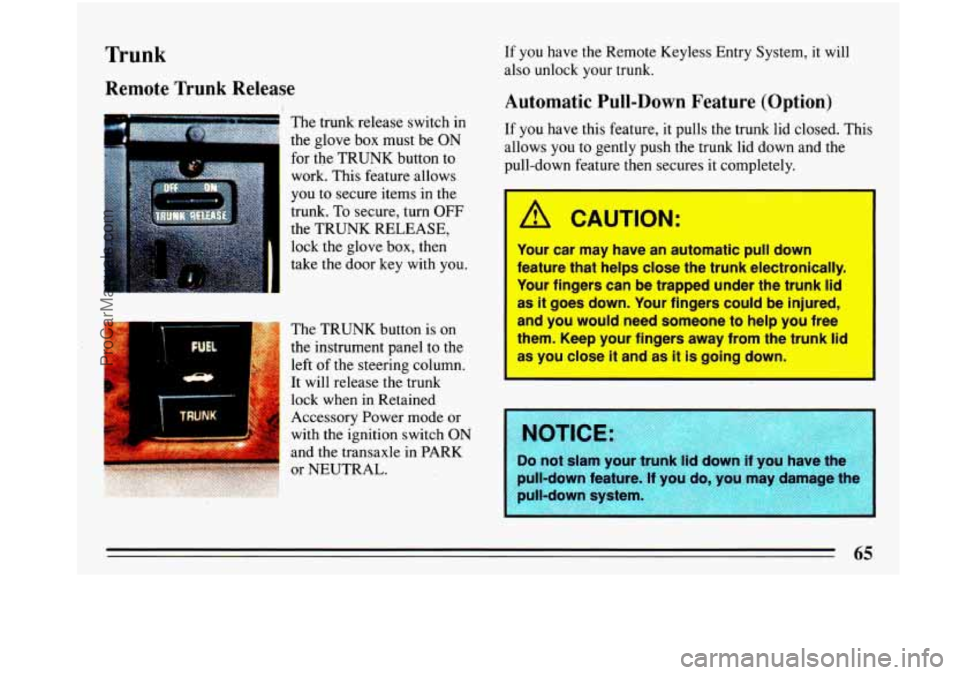
Trunk
Remote Trunk Release
I
The trunk release switch in
the glove
box must be ON
for the TRUNK button to
work. This feature allows
you
to secure items in the
trunk.
To secure, turn OFF
i .= TRUNK
I
the TRUNK RELEASE,
lock the glove box, then
take the door key with you.
The TRUNK button is on
the instrument panel
to the
left of the steering column.
It will release the trunk
lock when in Retained
Accessory Power mode or
with the ignition switch
ON
and the transaxle in PARK
If you have the Remote Keyless Entry System, it will
also unlock your trunk.
Automatic Pull-Down Feature (Option)
If you have this feature, it pulls the trunk lid closed. This
allows you to gently push the trunk lid down and the
pull-down feature then secures it completely.
/d CAUTION:
Your car may have an automatic pull down
feature that helps close the trunk electronically.
Your fingers can be trapped under the trunk lid
as it goes down. Your fingers could be injured,
and you would need someone
to help you free
them. Keep your fingers away from the trunk lid
as you close
it and as it is going down.
NOTICE:
Do not slam your LI UI ~r< lid QuvVn if you have th
pull-down feature. If you do, you may damage t
ProCarManuals.com
Page 73 of 340
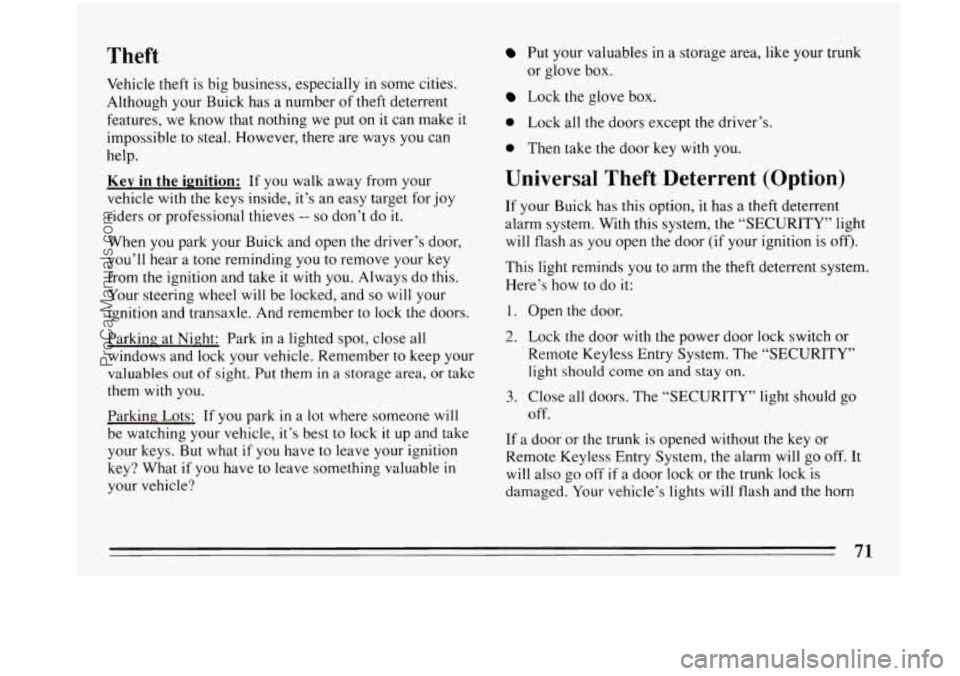
Theft
Vehicle theft is big business, especially in some cities.
Although your Buick has a number of theft deterrent
features, we know that nothing we put on
it can make it
impossible to steal. However, there are ways you can
help.
Kev in the ignition: If you walk away from your
vehicle with the keys inside, it’s an easy target for joy
riders or professional thieves
-- so don’t do it.
When you park your Buick and open the driver’s door,
you’ll hear a tone reminding you to remove your key
from
the ignition and take it with you. Always do this.
Your steering wheel will be locked, and
so will your
ignition and transaxle. And remember to lock the doors.
Parking at Night: Park in a lighted spot, close all
windows and lock your vehicle. Remember
to keep your
valuables
out of sight. Put them in a storage area, or take
them with you.
Parking. Lots: If you park
in a lot where someone will
be watching your vehicle, it’s best to lock
it up and take
your keys. But what if you have
to leave your ignition
key? What if you have to leave something valuable
in
your vehicle?
Put your valuables in a storage area, like your trunk
Lock the glove box.
or glove
box.
0 Lock all the doors except the driver’s.
0 Then take the door key with you.
Universal Theft Deterrent (Option)
If your Buick has this option, it has a theft deterrent
alarm system. With this system, the “SECURITY’’ light
will flash as
you open the door (if your ignition is off).
This light reminds you
to arm the theft deterrent system.
Here’s how to do it:
1. Open the door.
2. Lock the door with the power door lock switch or
Remote Keyless Entry System. The “SECURITY”
light should come on
and stay on.
3. Close all doors. The “SECURITY” light should go
off.
If a door or the trunk is opened without the key or
Remote Keyless Entry System, the alarm will
go off. It
will also
go off if a door lock or the trunk lock is
damaged. Your vehicle’s lights will flash and the horn
71
ProCarManuals.com
Page 78 of 340
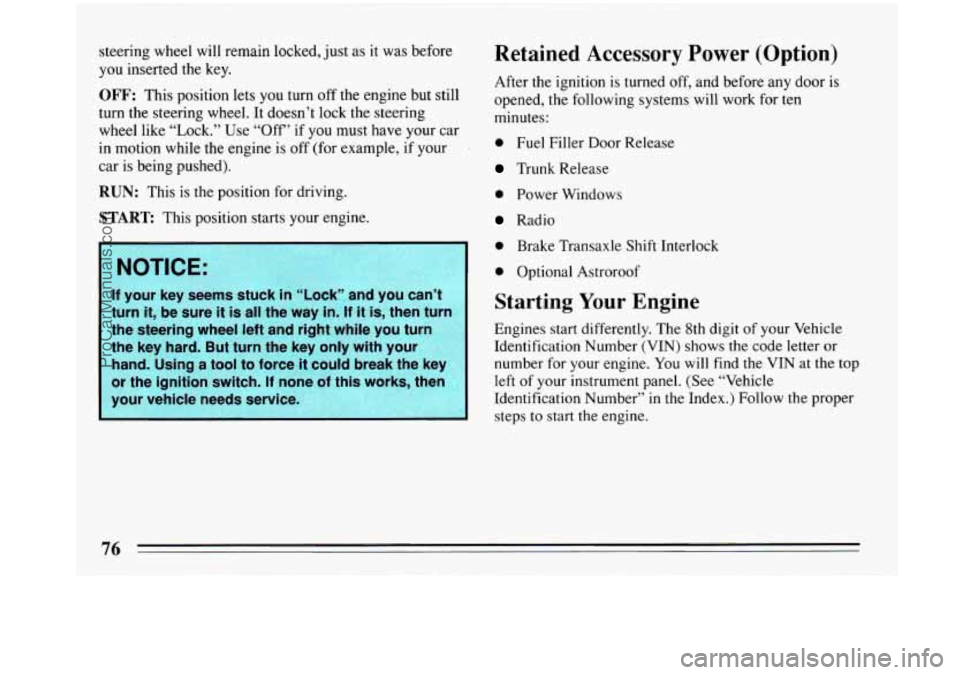
steering wheel will remain locked, just as it was before
you inserted the key.
OFF: This position lets you turn off the engine but still
turn the steering wheel.
It doesn’t lock the steering
wheel like “Lock.” Use “Off’ if
you must have your car
in motion while the engine is off (for example, if your
car is being pushed).
RUN: This is the position for driving.
START This position starts your engine.
NOTICE:
If your key seems stuck in “Lock” and you can’t
turn
it, be sure it is all the way in. If it is, then turn
the steering wheel left and right while you turn
the key hard. But turn the key only with your
hand. Using a tool to force
it could break the key
or the ignition switch. If none of this works, then
your vehicle needs service.
p’
Retained Accessory Power (Option)
After the ignition is turned off, and before any door is
opened, the following systems will work for ten
minutes:
0 Fuel Filler Door Release
Trunk Release
0 Power Windows
Radio
0 Brake Transaxle Shift Interlock
0 Optional Astroroof
Starting Your Engine
Engines start differently. The 8th digit of your Vehicle
Identification Number
(VIN) shows the code letter or
number for your engine. You will find the
VIN at the top
left of your instrument panel. (See “Vehicle
Identification Number” in the Index.) Follow the proper
steps to start the engine.
ProCarManuals.com
Page 92 of 340
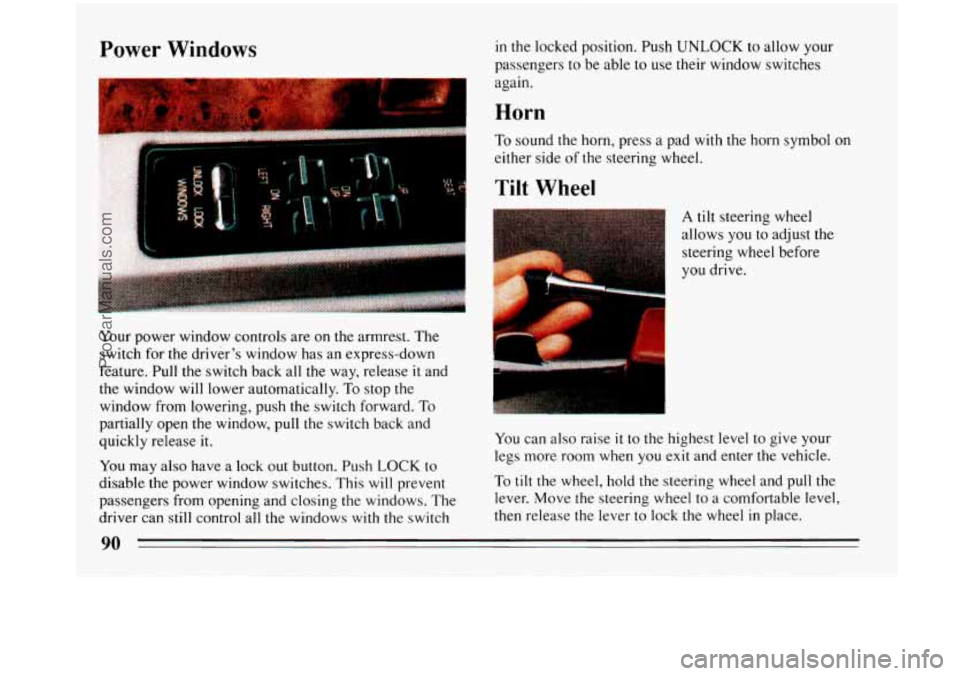
Power Windows
I
Your power window controls are on the armrest. The
switch for the driver’s window has an express-down
feature. Pull the switch back all
the way, release it and
the window will lower automatically.
To stop the
window from lowering, push the switch forward.
To
partially open the window, pull the switch back and
quickly release it.
You may
also have a lock out button. Push LOCK to
disable the power window switches. This will prevent
passengers
from opening and closing the windows. The
driver can still control all the windows
with the switch
in the locked position. Push UNLOCK to allow your
passengers to be able to use their window switches
again.
Horn
To sound the horn, press a pad with the horn symbol on
either side
of the steering wheel.
Tilt Wheel
i
I
A tilt steering wheel
allows you to adjust the
steering wheel before
you drive.
You can also raise it to the highest level to give your
legs more room when
you exit and enter the vehicle.
To
tilt the wheel, hold the steering wheel and pull the
lever. Move the steering wheel to
a comfortable level,
then release the lever to lock
the wheel in place.
ProCarManuals.com
Page 178 of 340
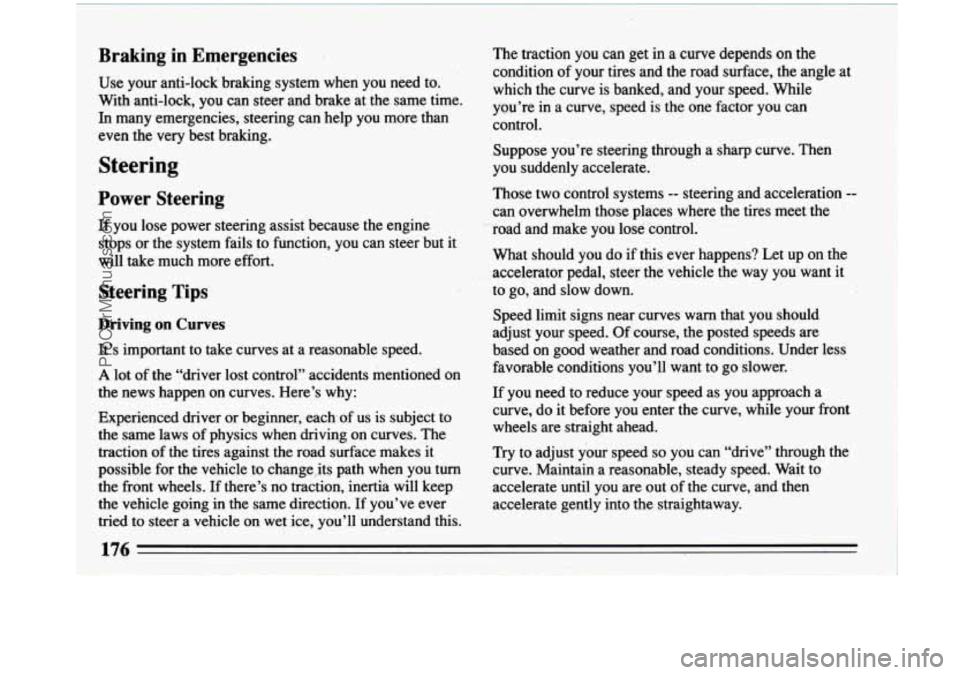
Braking in Emergencies
Use your anti-lock braking system when you need to.
With anti-lock, you ‘can steer and brake at the same time.
In many emergencies, steering can help you more than
even the very best braking.
Steering
Power Steering
If you lose power steering assist because the engine
stops
or the system fails to function, you can steer but it
.will take much more effort.
Steering Tips
Driving on Curves
It’s important to take curves at a reasonable speed.
A lot of the “driver lost control” accidents mentioned on
the news happen on curves. Here’s
why:
Experienced driver or beginner, each.of us is subject to
the same laws of physics when driving on curves. The
traction of the tires against the road surface makes it
possible for the vehicle to changejts path when you
turn
the front wheels. If there’s no traction, inertia will keep
the vehicle going in the same direction. If you’ve ever
tried to steer a vehicle on wet ice, you’ll understand this. The
traction you can get in a curve depends on the
condition of your tires and the road surface, the angle
at
which the curve is banked, and your speed. While
you’re in a curve, speed is the one factor you can
control.
Suppose you’re steering through a sharp curve. Then
you suddenly accelerate.
Those two control systems
-- steering .and acceleration --
can overwhelm those places where the tires meet the
road and make you lose control.
What should you do
if this ever happens? Let up on the
.accelerator pedal, steer the vehicle the way you want it
to go, and slow down.
Speed limit signs near curves
warn that you should
adjust your speed. Of course,
the posted speeds are
based on good weather and road conditions. Under less
favorable conditions you’ll want to go slower.
If you need to reduce your speed as you approach a
curve, do it before you enter the curve, while your front
wheels are straight ahead.
Try to adjust
your speed so you can “drive” through the
curve. Maintain a reasonable, steady speed. Wait to
accelerate until you are out of the curve, and then
accelerate gently into the straightaway.
176 I
ProCarManuals.com
Page 243 of 340
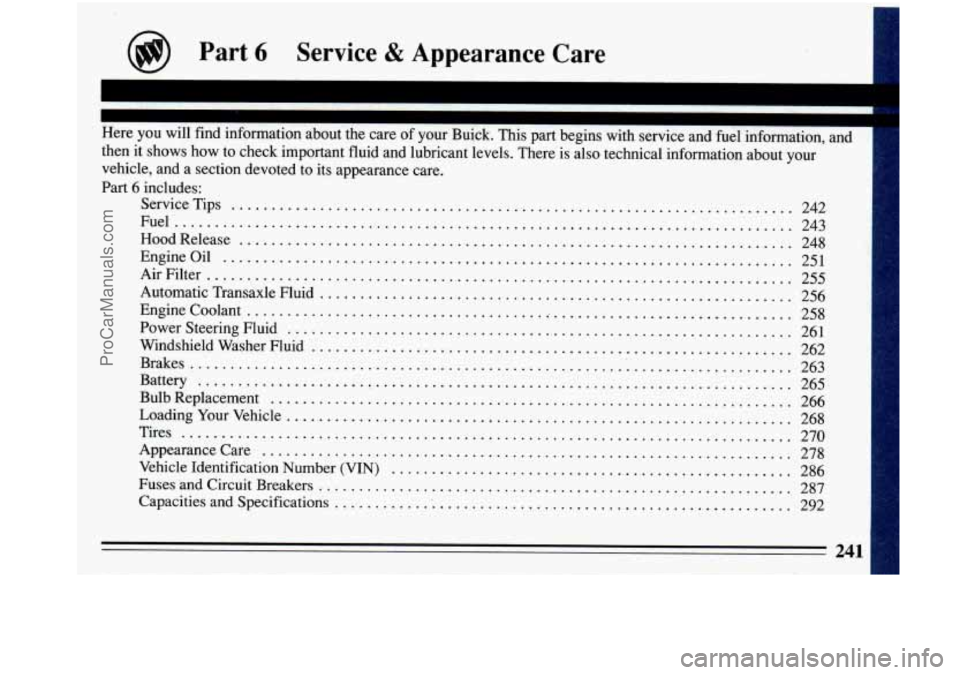
I
I
Here you will find information about the care of your Buick . This part begins with service and fuel information. and
then it shows how to check important fluid and lubricant levels
. There is also technical information about your
vehicle. and a section devoted to its appearance care
.
Part 6 includes:
ServiceTips
......................................................................
Engineoil ....................................................................... \
242
Fuel
........................................................................\
..... 243
Hood Release 248
251
AirFilter
........................................................................\
. 255
Automatic Transaxle Fluid
...........................................................
Enginecoolant .................................................................... 258
PowerSteeringFluid
............................................................... 261
Windshield Washer Fluid
............................................................ 262
Brakes
........................................................................\
... 263
Battery
........................................................................\
... 265
266
268
270
278
Vehicle Identification Number (VIN)
.................................................. 286
Fuses .and Circuit Breakers
........................................................... 287
Capacities and Specifications
.......................................................... 292
.....................................................................
256
BulbReplacement
.................................................................
LoadingYourVehicle ...............................................................
Tires ........................................................................\
....
Appearancecare ..................................................................
241
ProCarManuals.com
Page 253 of 340
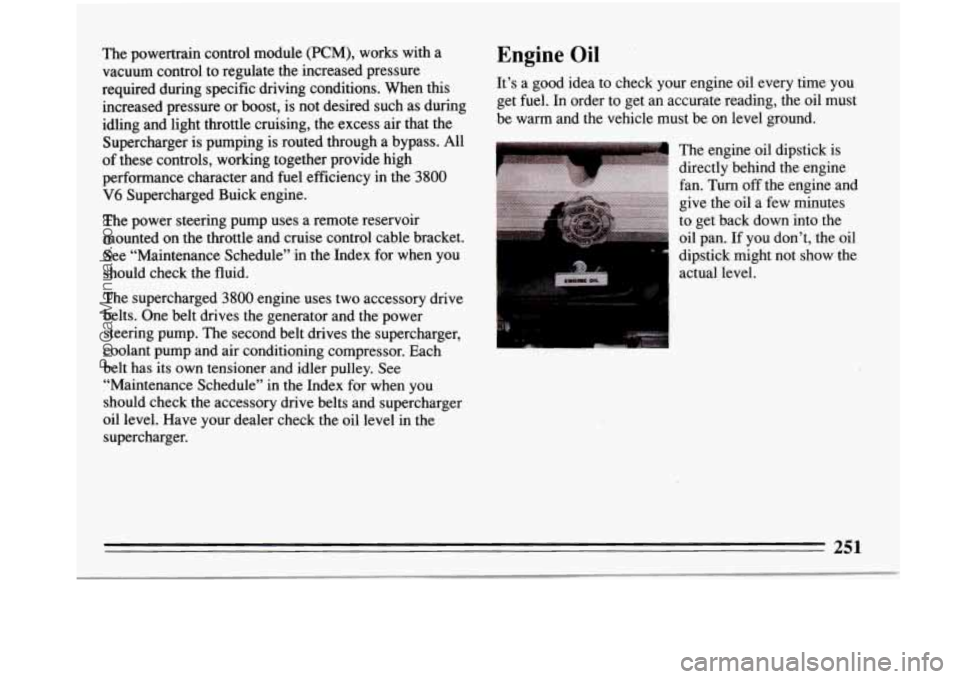
The powertrain control module (PCM), works with a
vacuum control to regulate the increased pressure
required during specific driving conditions. When this
increased pressure or boost, is not desired such as during
idling and light throttle cruising, the excess air that the
Supercharger is pumping is routed through a bypass. All
of these controls, working together provide high
performance character and fuel efficiency in the
3800
V6 Supercharged Buick engine.
The power steering pump uses a remote reservoir
mounted on the throttle and cruise control cable bracket.
See “Maintenance Schedule’’ in the Index for when you
should check the fluid.
The supercharged
3800 engine uses two accessory drive
belts. One belt drives the generator and the power
steering pump. The second belt drives the supercharger,
coolant pump and air conditioning compressor. Each
belt has
its own tensioner and idler pulley. See
“Maintenance Schedule’’ in the Index for when you
should check the accessory drive belts and supercharger
oil level. Have your dealer check the oil level in the
supercharger.
Engine Oil
It’s a good idea to check your engine oil every time you
get fuel. In order to get an accurate reading, the oil must
be warm and the vehicle must be on level ground.
The engine oil dipstick is
directly behind the engine
fan. Turn
off the engine and
give the oil a few minutes
to get back down into the
oil pan. If you don’t, the oil
dipstick might not &ow the
actual level.
ProCarManuals.com
Page 263 of 340
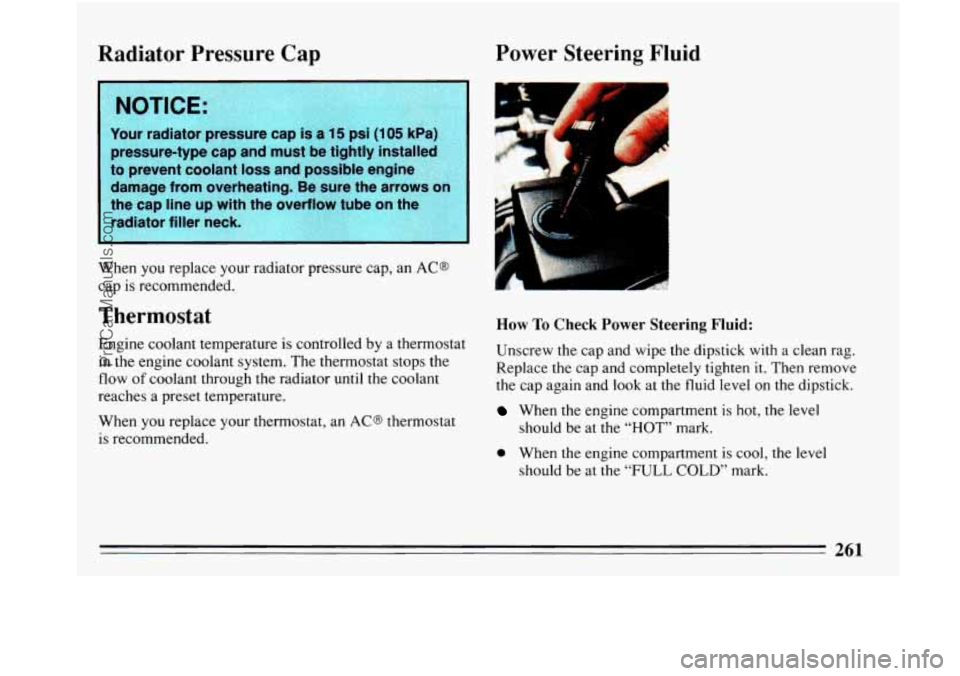
Radiator Pressure Cap
Your radiator pressure cap is a 15 psi (105 kPa)
pressure-type cap and must be tightly install
to prevent coolant
loss and possible engine
damage from overheating. Be sure the arro
the cap line up with the
ov be on t
radiator filler neck.
Power Steering Fluid
When you replace your radiator pressure cap, an AC@
cap
is recommended.
Thermostat
Engine coolant temperature is controlled by a thermostat
in the engine coolant system. The thermostat stops the
flow
of coolant through the radiator until the coolant
reaches a preset temperature.
When
you replace your thermostat, an AC@ thermostat
is recommended.
How To Check Power Steering Fluid:
Unscrew the cap and wipe the dipstick with a clean rag.
Replace
the cap and completely tighten it. Then remove
the cap again and look at the fluid level on the dipstick.
When the engine compartment is hot, the level
should be at the
“HOT” mark.
0 When the engine compartment is cool, the level
should be at the “FULL COLD” mark.
ProCarManuals.com